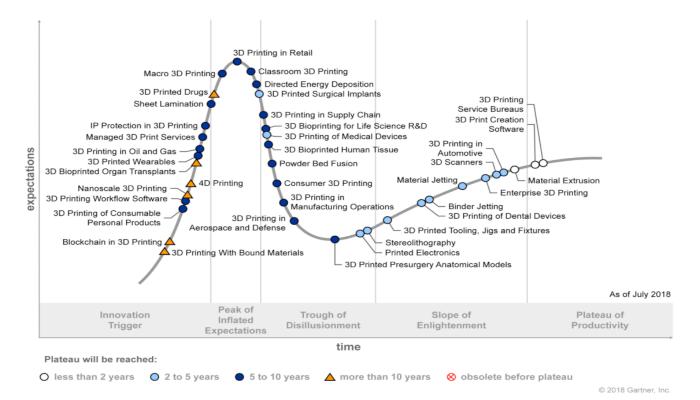Editor-in-Chief
- FMA
- The Fabricator
- FABTECH
- Canadian Metalworking
Our Publications
Categories
- Additive Manufacturing
- Aluminum Welding
- Arc Welding
- Assembly and Joining
- Automation and Robotics
- Bending and Forming
- Consumables
- Cutting and Weld Prep
- Electric Vehicles
- En Español
- Finishing
- Hydroforming
- Laser Cutting
- Laser Welding
- Machining
- Manufacturing Software
- Materials Handling
- Metals/Materials
- Oxyfuel Cutting
- Plasma Cutting
- Power Tools
- Punching and Other Holemaking
- Roll Forming
- Safety
- Sawing
- Shearing
- Shop Management
- Testing and Measuring
- Tube and Pipe Fabrication
- Tube and Pipe Production
- Waterjet Cutting
Industry Directory
Webcasts
Podcasts
FAB 40
Advertise
Subscribe
Account Login
Search
Why can’t additive manufacturing gain traction as a production process?
AM has been beset by the same problems for decades.
- By Don Nelson
- September 25, 2020
I first learned about the Gartner “Hype Cycle for 3D Printing” in 2015, around the time I started reporting regularly on additive and other digital manufacturing technologies. What particularly interested me was the Trough of Disillusionment.
The trough is littered with no-way-in-hell-is-this-going-to-work ideas, such as one day droves of consumers will buy 3D printers for home use. There are also what I consider plausible ideas, like someday 3D printing will occupy more than a niche in the manufacturing industry.
Both of these ideas were trough-dwellers in the 2015, 2017, 2018, and 2019 installments of the Hype Cycle. (Gartner didn’t prepare a 2020 version.) I recently compared the 2015 and 2019 troughs and discovered not much changed in four years.
In 2015, when enthusiasm for additive manufacturing was at a low point, Gartner projected that it would take five to 10 years for consumer and industrial 3D printing to reach the Plateau of Productivity. (This is the point at which a technology has been accepted and its use begins to grow.) Last year’s Hype report projected that it will still take five to 10 years for consumer and industrial printing to attain plateau status.
Whassup? Why is AM still running in place after nearly 40 years?
A major reason is the relative slowness of certain phases of 3D printing. Postprocessing is one.
PostProcess Technologies just published a survey that asked additive manufacturers to identify postprocessing-related “pain points” (see our article that begins on page 26). The No. 1 complaint was that postprinting work took too long (62.8%), followed by the inconsistency of finished parts (49.7%), and the skilled-labor costs expended for a task that doesn’t add value to the product (29.9%).
The survey also reported that 75% of respondents believe existing postprocessing technologies will prevent them from meeting future production goals.
The results of another recently published survey suggest that enthusiasm for AM will wane if barriers to production aren’t removed. Enable Manufacturing Ltd., a U.K. company that specializes in additively manufacturing casting molds, conducted the survey and wrote the follow-up report, titled “Is the Additive Manufacturing Bubble About to Burst?”
More than half of the respondents said AM is an unsuitable manufacturing method for form, fit, and functional prototypes, and 68% feel it isn’t suitable for production. “Main concerns were quality and performance for both prototyping and production, while cost was one of the major obstacles for use of AM in production,” wrote the authors.

3D printing as a manufacturing operation has been mired in the Gartner Hype Cycle Trough of Disillusionment for years. Gartner
The report identifies four barriers that must be eliminated for AM to gain widespread acceptance:
1. Cost. Designing and optimizing parts specifically for AM processes will drive down costs.
2. Quality. Respondents expressed concerns about the quality of AM materials. Additive manufacturers need to provide better documentation about material properties, and the industry must develop materials standards.
3. Scalability. Printers are small, which limits their capacity. Purchasing more printers to scale up is costly. “As of today, scalability remains a major challenge with no acceptable solution in sight,” says the report.
4. Confidence. AM businesses must constantly communicate with the market, informing stakeholders of the technology’s strengths and weaknesses. This will help engineers make informed choices.
Surveys and reports often raise as many question as they answer, if not more. Foremost among the questions about AM is who or what is going to airlift the industry from the Trough of Disillusionment?
A technology with the landscape-changing capability of the first iPhone? You? Me? All of us? All of the above?
About the Author

Don Nelson
2135 Point Blvd.
Elgin, IL 60123
(815)-227-8248
About the Publication
- Podcasting
- Podcast:
- The Fabricator Podcast
- Published:
- 04/16/2024
- Running Time:
- 63:29
In this episode of The Fabricator Podcast, Caleb Chamberlain, co-founder and CEO of OSH Cut, discusses his company’s...
- Trending Articles
- Industry Events
16th Annual Safety Conference
- April 30 - May 1, 2024
- Elgin,
Pipe and Tube Conference
- May 21 - 22, 2024
- Omaha, NE
World-Class Roll Forming Workshop
- June 5 - 6, 2024
- Louisville, KY
Advanced Laser Application Workshop
- June 25 - 27, 2024
- Novi, MI



























